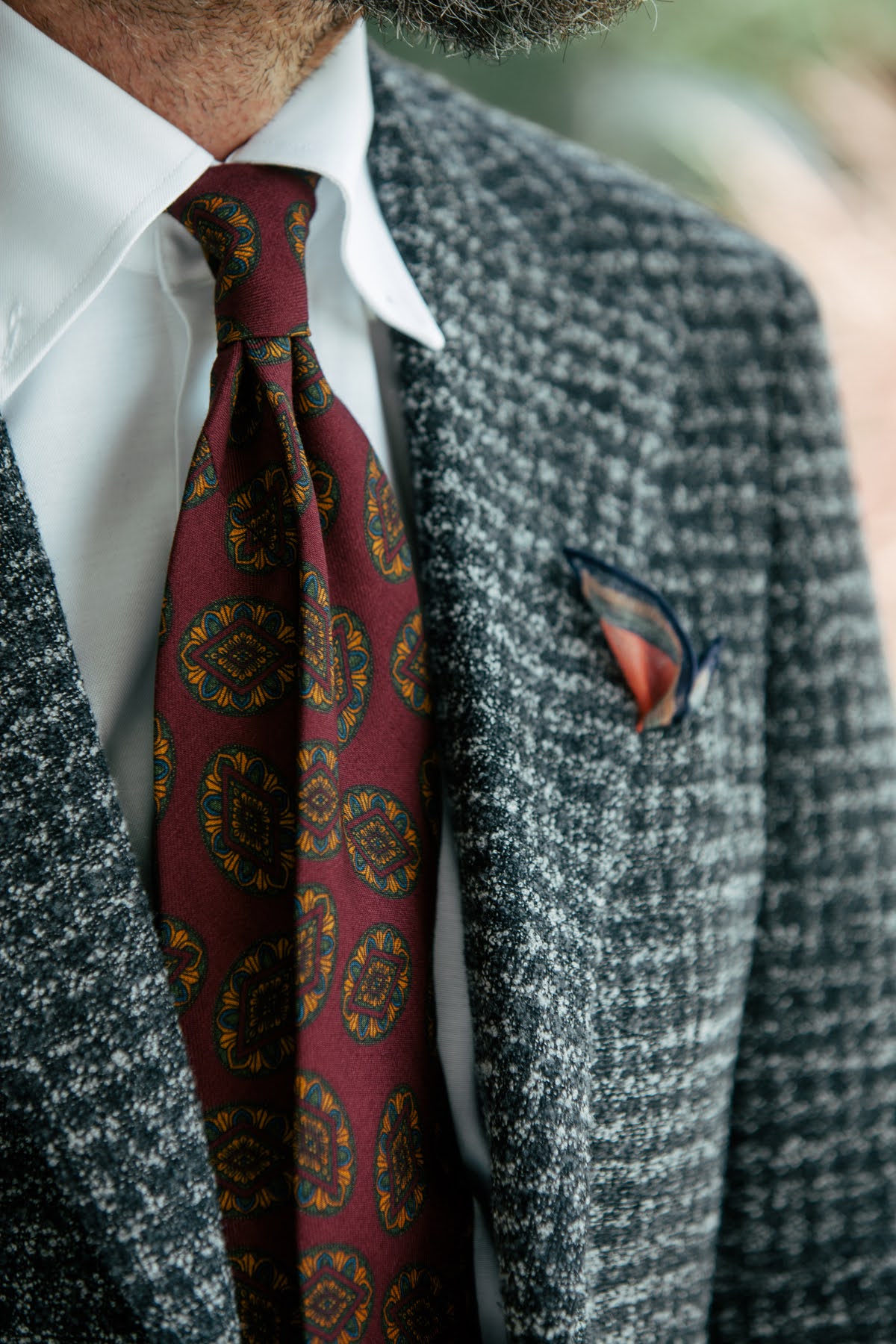Probably the best tie in our history
2022-09-21

It is a fairly common phenomenon that those who enjoy good clothing and the art of tailoring prefer autumn and winter to the hot seasons. The
reason is simple - you can wear more. When talking about winter
wardrobe, a fairly wide collection usually comes to mind; tweed jackets,
flannel trousers, chunky sweaters with and without braids, knitted
beanies (let's not forget the good old pom-pom...), woollen checked
scarves, sometimes corduroy in various guises, not to mention thicker
coats and outerwear in all forms.

Rarely do we
think of accessories alone, more belonging to the aesthetic rather than
the purely practical sphere - which is a pity, because our outfit is
made up of many elements, especially in winter, where we can even go
wild with layers and accessories. Today, we're going to talk about an
autumn and winter tie - and not just any tie, but a woollen one, the wool challis to be precise.
The origins of
the fabric known as wool challis are not exactly clear. The established
fact is that it was invented in England (the city of Norwich is most
often cited as their cradle) and originally resembled silk crepe
althought without it's sheen, and was closer to it in terms of texture,
softness and grip. Challis was not exclusively a woollen fabric -
it was originally woven from combinations of fibres such as wool and
silk, sometimes also with the addition of cotton. Today, wool challis is
considered to be a pure wool fabric, without a strictly defined weave,
with a soft, fine, yet hardygrip - it may remind us of carded wool
suitings.

During the
golden age of English textile and dyeing, the patterns of these fabrics
were printed by hand using wooden frames. Today, the mechanics of the
process are similar, although the small wooden frames are replaced by
industrial-sized steel frames. The product is a fabric that is pleasant to the touch, soft and with a slightly scratchy feel, while at the same time light as silk.
Due to the finishing and printing process, the colours (of both the
fabric and the printed pattern) are muted and somewhat bleak, yet clear
and eye-catching in their subtlety. In the hands of a skillful
craftsman, this textile treasure is transformed into an amazing tie.

The colours we
associate with autumn and winter - earthy and nutty browns, sometimes
ambiguously turning into the colours of ripe red wine, forest greens
smouldered with moss and pine cones, faded but eternally deep azure
weaved with aged gold, occasionally oranges and vivid citrus tones make
the view more pleasant. Mention must be made of berry violets and all
the light golden beiges reminiscent of the harvest. Now imagine these
colourful escapades spilled onto a tie. This is the colour prism through which we should see these ties.


The initiated
reader will, of course, know that ties do not live by colours alone -
after all, these colours need to be spun into some kind of shape. There
is no shortage of choice, although in this case, the patterns are usually classic but informal.
All sorts of ornamented and openwork diamonds, squares, ovals, larger
and smaller medallions, filled with the right colours for the
composition. The so-called Indian paisley pattern is also common. For
clothing conservatives, there are sometimes simple but firm
single-colour peas. For those fond of rustic and undeniably English
patterns, ducks, hounds, grouse, pheasants, foxes, horsemen in red and
other all kinds of hunting motifs against a background of calm green,
brown or navy blue are frequent choices. Not a very original thesis, but
there is something for everyone in this genre.

But let's move on to practice, because we can write papers about the patterns and colours in this case. Wool challis ties are informal ties.
So let's put away the suits made of the ubiquitous high-twist wools and
opt for something more cosy, perhaps even country styled. The tie
itself has its origins in England, so it's worth pairing it with
materials from its motherland; tweed jackets of various cuts (a nod here
to all the purely practical variations of this garment, such as the
hacking jacket or various hunting jackets), preferably with patch
pockets. Don't be afraid of the leather buttons that were once so
characteristic for this type of jacket. More elegant flannels and other
combed fabrics are of course also suitable, whether in the form of more
elegant sports suits or separate coordinated outfits.

Sweaters,
especially those worn under a jacket, such as thin cardigans or
pullovers, are also appropriate. If you're not thinking of a suit,
trousers made from a variety of corduroy, whether narrow or wide wale,
will work well underneath, and if you don't feel it, you can always go
back to good old grey flannels. Good old-fashioned jeans, especially
those in darker, deeper shades of navy blue, are also a great
alternative to dress trousers. To complete the look, pebble or country
grain leather, or suede shoes. Oxfords will work, although it's best to
wear a pair with rich brogueing, and taller boots - we're already thinking about colder temperatures.

Show more entries from
September 2022
Recommended

Burgundy Corduroy Button Down Albini Shirt
